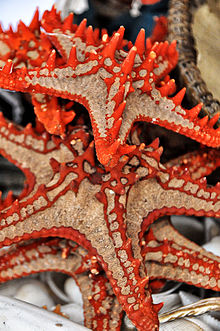en
names in breadcrumbs


Protoreaster lincki, the red knob sea star, red spine star, African sea star,[1] or the African red knob sea star,[2] is a species of starfish from the Indian Ocean.[3][4]

P. lincki grows to a maximum diameter of 12 in (30 cm). It has numerous tubercles located along its five arms. These tubercles are bright red and extend upward from the arms. It has a gray body with red stripes that connect the tubercles. This creates an appearance of a grid made of interconnecting wires.[5]
The skeleton is composed of many calcareous ossicles and spicules. They are located inside the layer of connective tissue. This skeleton supports the large central disk.[6]
In Kenya.
Close to a dead Astropyga radiata
It is distributed in the western Indian Ocean[7][8]
The red-knobbed starfish can only be found in the Indian Ocean, mostly along the African coast and Madagascar, north to India and Sri Lanka. A small population is also present in Coral Bay, Western Australia.[9]
They prefer sandy or muddy seabeds because it is easier for them to search and forage for food. While they are most often seen in shallow tidal pools, they can live in a variety of depths, down to 100 m (330 ft) deep.[10] Red-knobbed starfish are carnivorous animals that eat a number of sea creatures.
P. lincki is active in both daytime and nightime.[11] It is a popular aquarium specimen, but is considered incompatible with many other invertebrates, as it will eat soft corals, sponges, tube worms, clams, other starfish, and the like.[12]
It is also a heavily fished species for the curios trade, which contributes to the rarefaction of the species.[9]
Protoreaster lincki, the red knob sea star, red spine star, African sea star, or the African red knob sea star, is a species of starfish from the Indian Ocean.
Protoreaster lincki est une espèce d'étoile de mer tropicale de la famille des Oreasteridées.
C'est une grosse étoile de 25 à 30 cm de diamètre[1], au corps rigide, et pourvue de cinq bras robustes. Le tégument est blanc à gris-clair, mais parcouru par un réseau rouge vif reliant entre elles de gros tubercules émoussés qui hérissent toute la face orale (mais jamais la marge actinale entre les bras), formant des motifs géométriques[2]. Ces tubercules sont parfois plus clairs à la pointe, et légèrement plus pointus et plus denses au bout des bras ; leur forme, leur taille et leur nombre sont assez variables[3]. La face orale est rouge, mis à part les fins sillons ambulacraires blancs[2],[4].
Au Kenya.
À côté d'un Astropyga radiata mort (peut-être un comportement charognard)
On trouve cette étoile sur les fonds sableux et dans les herbiers marins de l'océan Indien occidental, notamment tout le long de la côte est-africaine tropicale (Kenya, Tanzanie, Mozambique, Madagascar...)[5], mais aussi jusqu'en mer d'Andaman, et une petite population isolée existe dans le nord-ouest de l'Australie[2].
Elle vit principalement à proximité de la surface (elle se retrouve facilement émergée à marée basse), mais peut être trouvée jusqu'à 100 m de profondeur[2].
La protoreaster asterlinki Juvénile broute des algues.
C'est une espèce qui semble principalement détritivore, se nourrissant de débris alimentaires et occasionnellement de charognes[3].
Cette étoile est absolument inoffensive, et ses pointes ne piquent pas. Comme elle vit à faible profondeur sur les plages et est pourvue de couleurs vives, elle est un des symboles des plages de la côte est-africaine[5]. Mais ce succès lui coûte : comme sa sœur du Pacifique Protoreaster nodosus, elle est souvent prélevée de son milieu et séchée pour des raisons décoratives[3], ce qui a entraîné un effondrement de sa population ces 50 dernières années[6].
Protoreaster lincki est une espèce d'étoile de mer tropicale de la famille des Oreasteridées.